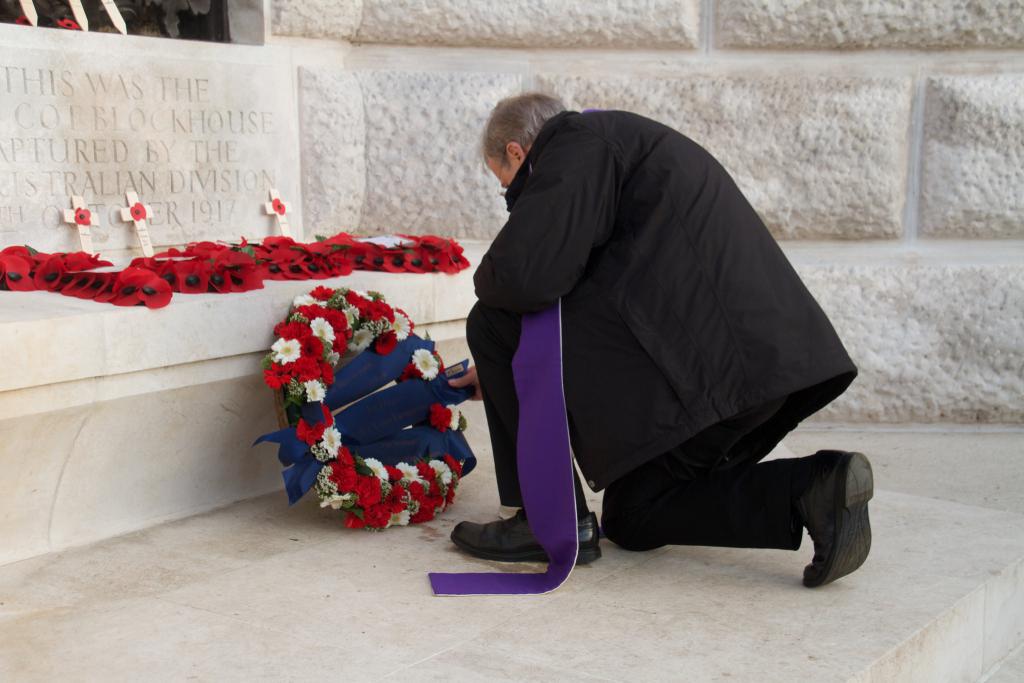by Bishop Nicholas Hudson
I will never forget my visit to the German cemetery at Ypres. It was just before the Armistice centenary. I was with bishops from the twenty-eight member-countries of the European Union to commemorate the dead who lay all around us. Each bishop was invited to identify one grave, lay upon it a white rose and pray for the repose of the soul of that one fallen soldier. As I stood over the grave of Franz Podemski, it occurred to me his grave had possibly never been visited before, let alone prayed over. Having prayed for the fallen Germans, it was powerful then to proceed to Tyne Cot to commemorate all those British and Commonwealth servicemen who had perished similarly at Passchendaele, including two of my own great uncles. There we made the same profound gesture, each laying a rose beneath the headstone of one chosen soldier, praying that his soul enjoy eternal rest.
Flanders Fields are very human. You could be tempted to think of them as inhuman, given the destruction of life they witnessed. But they are very human, and these cemeteries deeply human, in the sense of celebrating the unique cost of every man and boy that lies there. They are human as well in the sense that Pope Francis meant when he called upon the Christians of this continent, in his address to the ‘Re-thinking Europe’ conference to remind Europe ‘that she is not a mass of statistics or institutions but is made up of people.’ Work to maintain a radical spirit of community, he continued; work to create communities which keep the poorest and the most vulnerable at their heart. To illustrate this, he highlighted the extraordinary contribution made in the Middle Ages by St Benedict to the shaping of Europe through the establishment of communities, significant because they placed the human at their centre.
To keep the human at the centre: that is why Jesus came, to help us believe that every human is made in the image and likeness of God. Jesus also taught that it is when we reach out to the most vulnerable in society that we reach out to him. So the admonition of St John Chrysostom touches deep chords within us, especially at this time of year as we deck the halls and load the tables: ‘Do you wish to honour the Body of Christ?’ asks St John. ’Then do not despise him when he is naked. Do not honour him here in the church building with silks, only to neglect him outside, when he is suffering from cold and from nakedness. For he who said, ‘This is my body’ is the same who said, ‘You saw me, a hungry man, and you did not give me to eat.’ Of what use is it to load the table of Christ? Feed the hungry and then come and decorate the table. You are giving a golden chalice and you do not give a cup of cold water?’
This year saw the canonization of another saintly champion of the poor, one who made the supreme sacrifice to keep the human at the heart of his nation’s concerns: St Oscar Romero. From first to last, it was the human which drove this holy Archbishop, inspired him to risk all by preaching words like those he preached at Midnight Mass the Christmas before he died: ‘If we wish to find the child Jesus today,’ he said simply, ‘we should not expect to find him in beautiful crib figures: we should look for him rather among the malnourished children who went to bed tonight with nothing to eat. We should look for him among the poor newspaper boys who will sleep tonight on doorsteps, wrapped in their papers.’
We will find God, Romero is saying, in the human, in the poorest human beings. Soon after we celebrated Romero, I found myself touching these deeply human realities once again in the place where hostilities had ceased a century ago. I had come to Picardy, to the Forest of Compiègne, wherein nestles the railway carriage in which the Armistice was signed. It is surely no coincidence that it was in the same forest, some forty years later, there was born L’Arche, the Ark, when Jean Vanier first welcomed two men with learning disabilities into his home. Jean says he had no idea that he was creating a new world movement. ‘All I knew,’ he says, ‘was that I was doing something irrevocable.’ He knew he was welcoming Christ. And so L’Arche was born; and Christ: Christ the Prince of Peace was born anew in the Forest of Peace, Compiègne, which will be forever the Armistice Wood.
My prayer is that he be born again our hearts this Christmas, to make us, each in our own unique way, bearers of his peace.
Photo: COMECE The Catholic Church in the European Union




